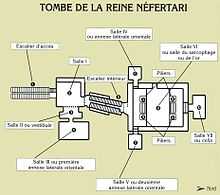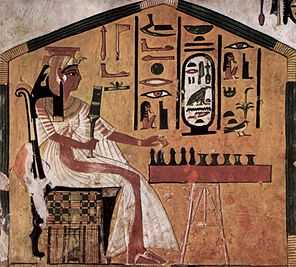QV66
| QV66 | |||
|---|---|---|---|
| Burial site of Nefertari | |||
|
Nefertari playing Senet | |||
 QV66 | |||
| Coordinates | 25°43′40.3″N 32°35′33.4″E / 25.727861°N 32.592611°ECoordinates: 25°43′40.3″N 32°35′33.4″E / 25.727861°N 32.592611°E | ||
| Location | Valley of the Queens | ||
| Discovered | 1904 | ||
| Decoration | Book of the Dead | ||
| Layout | Generally straight | ||
| |||

QV66 is the tomb of Nefertari, the Great Wife of Ramesses II, in Egypt's Valley of the Queens. It was discovered by Ernesto Schiaparelli (the director of the Egyptian Museum in Turin) in 1904. It is called the Sistine Chapel of Ancient Egypt.
Decoration and layout
A flight of steps cut out of the rock gives access to the antechamber, which is decorated with paintings based on Chapter 17 of the Book of the Dead.[1] This astronomical ceiling represents the heavens and is painted in dark blue, with a myriad of golden five-pointed stars. The east wall of the antechamber is interrupted by a large opening flanked by representation of Osiris at left and Anubis at right; this in turn leads to the side chamber, decorated with offering scenes, preceded by a vestibule in which the paintings portray Nefertari being presented to the gods who welcome her. On the north wall of the antechamber is the stairway that goes down to the burial chamber.[1] This latter is a vast quadrangular room covering a surface area about 90 square meters, the astronomical ceiling of which is supported by four pillars entirely covered with decoration. Originally, the queen's red granite sarcophagus lay in the middle of this chamber.[1] According to religious doctrines of the time, it was in this chamber, which the ancient Egyptians called the "golden hall" that the regeneration of the deceased took place. This decorative pictogram of the walls in the burial chamber drew inspirations from chapters 144 and 146 of the Book of the Dead: in the left half of the chamber, there are passages from chapter 144 concerning the gates and doors of the kingdom of Osiris, their guardians, and the magic formulas that had to be uttered by the deceased in order to go past the doors.[1]
The tomb itself is primarily focused on the Queen’s life and on her death.
Ramesses’ affection for his wife, as written on her tomb's walls, shows clearly that Egyptian queens were not simply marriages of convenience or marriages designed to accumulate greater power and alliances, but, in some cases at least, were actually based around some kind of emotional attachment. Also poetry written by Ramesses about his dead wife is featured on some of the walls of her burial chamber. ("My love is unique — no one can rival her, for she is the most beautiful woman alive. Just by passing, she has stolen away my heart.") Nefertari’s origins are unknown except that it is thought that she was a member of the nobility, although while she was queen her brother Amenmose held the position of Mayor of Thebes.
By contemporary standards, the real value of the paintings found within the tomb is that they are the best preserved and most detailed source of the ancient Egyptian’s journey towards the afterlife. The tomb features several extracts from the Book of the Dead from chapters 148, 94, 146, 17 and 144 and tells of all the ceremonies and tests taking place from the death of Nefertari up until the end of her journey, depicted on the door of her burial chamber, in which Nefertari is reborn and emerges from the eastern horizon as a sun disc, forever immortalized in victory over the world of darkness.
The details of the ceremonies concerning the afterlife also tell us much about the duties and roles of many major and minor gods during the reign of the 19th Dynasty in the New Kingdom. Gods mentioned on the tomb walls include Isis, Osiris, Anubis, Hathor, Neith, Serket, Ma'at, Wadjet, Nekhbet, Amunet, Ra and Nephthys.
Unfortunately by the time that Schiaparelli rediscovered Nefertari’s tomb it had already been found by tomb raiders, who had stolen all the treasure buried with the Queen, including her sarcophagus and mummy. Parts of the mummy's knees were found in the burial chamber, and were taken to the Egyptian Museum in Turin by Schiaparelli, where they are still kept today.
Closure
The tomb was closed to the public in 1950 because of various problems that threatened the paintings, which are considered to be the best preserved and most eloquent decorations of any Egyptian burial site, found on almost every available surface in the tomb, including stars painted thousands of times on the ceiling of the burial chamber on a blue background to represent the sky.
In 1986, an operation to restore all the paintings within the tomb was embarked upon by the Egyptian Antiquities Organisation and the Getty Conservation Institute; however, work did not begin on the actual restoration until 1988 which was completed in April 1992. Upon completion of the restoration work, Egyptian authorities decided to severely restrict public access to the tomb in order to preserve the delicate paintings found within.
References
| Wikimedia Commons has media related to Tomb of Nefertari. |
